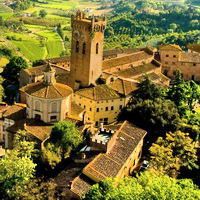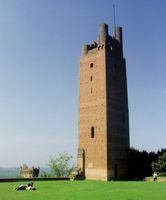 San Miniato is situated along the Via Francigena, which in the Middle Ages connected northern Europe to Rome. The city enjoys a favourable position in the heart of the Arno River valley, at the crossroads of highways leading to Florence, Pisa, Lucca and Siena.
San Miniato is situated along the Via Francigena, which in the Middle Ages connected northern Europe to Rome. The city enjoys a favourable position in the heart of the Arno River valley, at the crossroads of highways leading to Florence, Pisa, Lucca and Siena.
It is no surprise that San Miniato was favoured by emperors, such as Frederick II of Swabia, and by Popes, including Gregory V and Eugene IV. For instance, according to a manuscript by Buonarroti himself, in 1533 at San Miniato Michelangelo met Pope Clemente VII, who commissioned him the completion of the Sistine Chapel.
San Miniato took on a primary role under emperor Frederick II, known as Barbarossa, firstly becoming the base of the imperial delegate in Tuscany (in the Middle Ages the city was actually called San Miniato al Tedesco meaning “German San Miniato”), to later become an Episcopal seat. The construction of the Seminary, with its distinctive frescoed façade, and the restoration of the Bishop’s Palace, both located in the Cathedral area, date back to this period.
San Miniato was also the site of Roman and Etruscan settlement, as proven by the excavations of a 3rd-century B.C. necropolis at Fontevivo and a Roman villa at Antonini, whose artefacts are displayed in part in the Civic Museum.
All of this has left a significant artistic and architectural heritage that is offered to visitors, starting from the nucleus around the Prato del Duomo, a charming square situated in a raised position in relation to the rest of the town. The square is lined by some of the oldest and most prestigious buildings of the city, including the Palazzo Comunale, the Bishops’ Palace, the 14th-century Palazzo dei Vicari and the Cathedral.
The historic centre of San Miniato offers an interesting Museum System that allows admission to eight exhibition centres, including museums, historical buildings and collections with a single ticket. The Museum System leads visitors on an urban trail where the works can be enjoyed in their natural settings, instead of taking place in a single exhibition area.
 The itinerary comes to its natural conclusion at the Rocca Federiciana.
The itinerary comes to its natural conclusion at the Rocca Federiciana.
The tower, named after emperor Frederick II and built from 1217 to 1223, stands on top of the hill, where it constitutes the main element of the Rocca (fortress), of San Minato
At the end of the tour, which includes The Oratorio Loretino, the Diocesan Museum of Sacred Art and the Archaeological Museum, the top of the tower affords a beautiful view of the city, the Arno River valley, the Volterra hills and, on clear days, of the Tyrrhenian Sea.
An Educational Museum of Writing can be found at San Miniato Basso. The exhibition, intended primarily for children and students, covers the key stages in the history of writing from the Stone Age to the present day.
